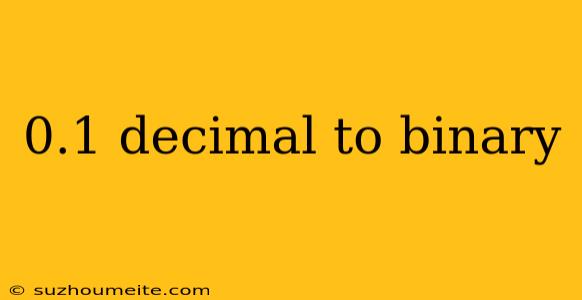0.1 Decimal to Binary
In this article, we will learn how to convert the decimal number 0.1 to binary. Before we dive into the conversion process, let's first understand what decimal and binary numbers are.
What are Decimal Numbers?
Decimal numbers are a base-10 number system that uses 10 distinct symbols: 0, 1, 2, 3, 4, 5, 6, 7, 8, and 9. This is the number system we use in our daily lives.
What are Binary Numbers?
Binary numbers are a base-2 number system that uses only two distinct symbols: 0 and 1. This is the number system used by computers to process and store data.
Converting 0.1 Decimal to Binary
To convert the decimal number 0.1 to binary, we can use the following steps:
Step 1: Multiply by 2
Multiply 0.1 by 2 to get 0.2.
Step 2: Take the Whole Number Part
Take the whole number part of the result, which is 0.
Step 3: Multiply the Fractional Part
Multiply the fractional part of the result (0.2) by 2 to get 0.4.
Step 4: Take the Whole Number Part
Take the whole number part of the result, which is 0.
Step 5: Multiply the Fractional Part
Multiply the fractional part of the result (0.4) by 2 to get 0.8.
Step 6: Take the Whole Number Part
Take the whole number part of the result, which is 0.
Step 7: Multiply the Fractional Part
Multiply the fractional part of the result (0.8) by 2 to get 1.6.
Step 8: Take the Whole Number Part
Take the whole number part of the result, which is 1.
The Binary Representation of 0.1
By repeating the steps above, we get the following binary representation of 0.1:
0.00011001100110011...
The dots indicate that the pattern repeats indefinitely.
In conclusion, the decimal number 0.1 is equivalent to the binary number 0.00011001100110011.... This conversion is essential in computer science, as it allows us to represent and process decimal numbers using binary code.
